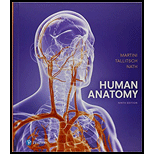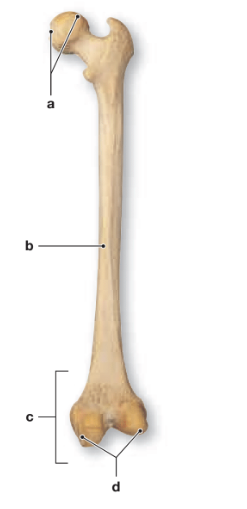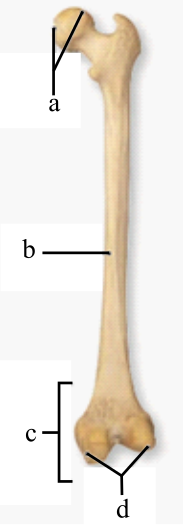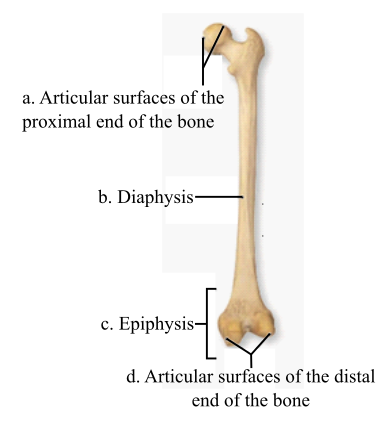
Concept explainers
Label the following structures on the accompanying diagram of a long bone.
■ diaphysis
■ articular surfaces of the proximal end of the bone
■ epiphysis
■ articular surfaces of the distal end of the bone

(a) ____
(b) ____
(c) ____
(d) ____
To review:
Label the following terms in the given diagram of a long bone: diaphysis, articular surfaces of the proximal end of the bone, epiphysis, and articular surfaces of the distal end of the bone.

Introduction:
Bone is the hard rigid structure that makes up the skeleton system of the body. It provides the framework to the body. The bones have two types of tissues, compact bone and spongy bone. The former is rigid, while the spongy forms an open networks of sheets. The compact bone is arranged in concentric layers around the spongy bone.
Explanation of Solution
The structures of the long bone are labeled as below:

The bones have two end that are known as proximal and distal epiphyses and these ends are separated by a long cylindrical shaft, which is called as diaphysis. The distal end points outwards from the center of the body, whereas the proximal end points toward the center of the body.
The junction where epiphysis meets the diaphysis is known as epiphyseal plate or metaphysis. In the diaphysis, there is hollow region, which is called as medullary cavity. The lining around the medullary cavity is endosteum, whereas the outermost covering of the bone providing blood is periosteum.
Therefore, the structures of a long bone are
| a | Articular surfaces of the proximal end of the bone |
| b | Diaphysis |
| c | Epiphysis |
| d | Articular surfaces of the distal end of the bone |
Want to see more full solutions like this?
Chapter 5 Solutions
Human Anatomy (9th Edition)
- What did the Cre-lox system used in the Kikuchi et al. 2010 heart regeneration experiment allow researchers to investigate? What was the purpose of the cmlc2 promoter? What is CreER and why was it used in this experiment? If constitutively active Cre was driven by the cmlc2 promoter, rather than an inducible CreER system, what color would you expect new cardiomyocytes in the regenerated area to be no matter what? Why?arrow_forwardWhat kind of organ size regulation is occurring when you graft multiple organs into a mouse and the graft weight stays the same?arrow_forwardWhat is the concept "calories consumed must equal calories burned" in regrads to nutrition?arrow_forward
- You intend to insert patched dominant negative DNA into the left half of the neural tube of a chick. 1) Which side of the neural tube would you put the positive electrode to ensure that the DNA ends up on the left side? 2) What would be the internal (within the embryo) control for this experiment? 3) How can you be sure that the electroporation method itself is not impacting the embryo? 4) What would you do to ensure that the electroporation is working? How can you tell?arrow_forwardDescribe a method to document the diffusion path and gradient of Sonic Hedgehog through the chicken embryo. If modifying the protein, what is one thing you have to consider in regards to maintaining the protein’s function?arrow_forwardThe following table is from Kumar et. al. Highly Selective Dopamine D3 Receptor (DR) Antagonists and Partial Agonists Based on Eticlopride and the D3R Crystal Structure: New Leads for Opioid Dependence Treatment. J. Med Chem 2016.arrow_forward
- The following figure is from Caterina et al. The capsaicin receptor: a heat activated ion channel in the pain pathway. Nature, 1997. Black boxes indicate capsaicin, white circles indicate resinferatoxin. You are a chef in a fancy new science-themed restaurant. You have a recipe that calls for 1 teaspoon of resinferatoxin, but you feel uncomfortable serving foods with "toxins" in them. How much capsaicin could you substitute instead?arrow_forwardWhat protein is necessary for packaging acetylcholine into synaptic vesicles?arrow_forward1. Match each vocabulary term to its best descriptor A. affinity B. efficacy C. inert D. mimic E. how drugs move through body F. how drugs bind Kd Bmax Agonist Antagonist Pharmacokinetics Pharmacodynamicsarrow_forward
 Medical Terminology for Health Professions, Spira...Health & NutritionISBN:9781305634350Author:Ann Ehrlich, Carol L. Schroeder, Laura Ehrlich, Katrina A. SchroederPublisher:Cengage Learning
Medical Terminology for Health Professions, Spira...Health & NutritionISBN:9781305634350Author:Ann Ehrlich, Carol L. Schroeder, Laura Ehrlich, Katrina A. SchroederPublisher:Cengage Learning Principles Of Radiographic Imaging: An Art And A ...Health & NutritionISBN:9781337711067Author:Richard R. Carlton, Arlene M. Adler, Vesna BalacPublisher:Cengage Learning
Principles Of Radiographic Imaging: An Art And A ...Health & NutritionISBN:9781337711067Author:Richard R. Carlton, Arlene M. Adler, Vesna BalacPublisher:Cengage Learning Comprehensive Medical Assisting: Administrative a...NursingISBN:9781305964792Author:Wilburta Q. Lindh, Carol D. Tamparo, Barbara M. Dahl, Julie Morris, Cindy CorreaPublisher:Cengage Learning
Comprehensive Medical Assisting: Administrative a...NursingISBN:9781305964792Author:Wilburta Q. Lindh, Carol D. Tamparo, Barbara M. Dahl, Julie Morris, Cindy CorreaPublisher:Cengage Learning





